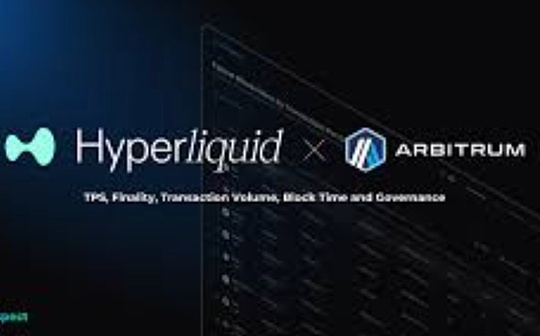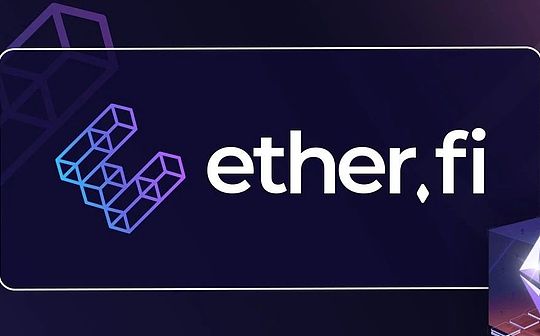
Source: Chain Tea House
1. Project introduction
Etherfi is an innovative project focusing on Ethereum pledge and liquidity re -pledge in the field of decentralized finance (DEFI).By providing non -hosting pledge solutions, Etherfi users can earn pledge income while maintaining the liquidity of assets, thereby solving the problem of locking of funds in traditional pledge.

Etherfi is based on a series of core principles to ensure the integrity and decentralization of the Ethereum ecosystem.These principles include decentralization, sustainability and ethical operations, and community priorities.Etherfi introduces a complex system that involves multiple stakeholders, such as pledges, node operators and node services, which are divided into three strategic stages: entrusting pledge, liquidity pools and node services.Through its innovative design, Etherfi enables the pledged to retain the control of its key, which is particularly prominent in the DEFI space.
In addition, Etherfi also introduced a liquid Staking Token (LST), that is, EETH, marking Etherfi’s commitment to liquidity and flexibility.
2. Operation principle
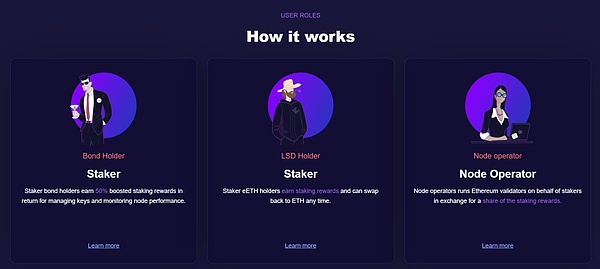
2.1The first stage: entrustment to pledge
At this stage, pledges can be entrusted with a 32 ETH unit to implement pledge, and through the following steps:
-
Node operator bidding: node operators submitted bidding to say they can allocate verification nodes.
-
Pledge and auction mechanism: The pledgers deposit 32 ETH into Etherfi’s deposit contracts, trigger auction mechanism and assign node operators to run the verification device.
-
Generate NFT and insurance mechanism: This process will cast two NFT (T-NFT and B-NFT), which represents the ownership of the extraction of the vault.B-NFT is the only one, and the insurance mechanism is provided when there is a problem with the verification device.
-
Key management and verification device startup: The pledgeer encrypted the verification device key and submitted it as a chain transaction. Node operators use the decrypted key to start the verification device.
-
Exit commands and funds recycling: pledges or node operators can issue exit orders, transfer the pledged ETH to the extraction vault, and destroy NFT to retrieve their ETH (deduction fee).
2.2The second stage: liquidity pool and EETH
At this stage, provide participation opportunities for pledges who have less than 32 ETH or who do not want to directly monitor and verify nodes:
-
Mixing of liquidity pools and assets: The liquidity pool contains ETH and T-NFTS, and ETH occupies a small proportion in the pool.
-
Casting and destroying EETH: When the pledged deposit ETH is stored in the pool, the pond will cast the EETH token and transfer it to the depositee.The pledgers holding T-NFT can also save them into the pool and cast an equivalent value.
-
EETH and ETH exchange: pledgers holding EETH can exchang it to ETH at a ratio of 1: 1 without enough liquidity.
2.3Third stage: node service
This is an outlook stage of the agreement, including many technical decisions that have not yet been decided:
-
NFT and node services: Use NFT to create programmable pledge infrastructure layers to create economic incentives for node operators and pledges.
-
Registration and management of node services: nodes can be registered to provide additional services, which requires the joint consent of node operators, B-NFT holders and Etherfi.
3. Core mechanism
3.1Entrusted and non -custody control
Etherfi allows pledges to maintain a complete control of their Ethereum keys, which is a key feature that is different from other pledge agreements.In Etherfi, pledges not only send their ETH to the protocol, but through a special mechanism to ensure that they still control their assets throughout the process.

3.1.1Entrusted pledge
In Etherfi, entrusted pledges to allow pledges to pledge its Ethereum into the network to support the operation and safety of Ethereum, but unlike the traditional pledge method, the pledker does not need to deliver ETH to centralized node operators or pledges.Pond.Instead, they can run the verification device through the Etherfi protocol while maintaining their asset control.This method reduces dependence on centralized entities and enhances decentralization and security.
3.1.2Non -custody control
Non -controlling control is another key feature of Etherfi, which ensures that the pledgers always control their crypto assets.In the EtherFi protocol, ETH of the pledged person will never leave their wallet or be transferred to the protocol control.Through the use of smart contracts and encryption technology, the pledgee generates and holds their own private key, and smart contracts handle pledge operations safely without transfer of control.
3.2NFT and Verification Management
In the EtherFi protocol, the combination of NFT (intangible homogeneous tokens) and verification device management is one of its core innovations. This mechanism greatly improves the flexibility and operability of Ethereum pledge.By using NFT as a direct management tool for the verification device, Etherfi provides a transparent, verified and decentralized management method for pledges.

3.2.1NFTization of the verification device
In Etherfi, the creation of each verification device is accompanied by a unique NFT casting.This NFT not only represents the ownership of the pledged funds on the verification device, but also includes all the key data required by the management and running verification device.
NFT content:
-
Verifying information: Including detailed information about nodes, physical location, node operators, and node services run by the verification device.
-
Management rights: NFT holders have the control of the verification device, including but not limited to the ability to start, stop, or re -configure the verification device.
-
Pickup ETH information: Each NFT is bound to a certain amount of ETH, usually 32 ETH, which is the standard pledge amount required to start a Ethereum verification device.
3.2.2Decentralization of verification device management
Through NFT, Etherfi allows pledges to manage its verification device in a very flexible and decentralized manner.This method reduces the common trust issues in traditional pledge services, and pledges do not have to transfer their ETH to third parties.
Operation process:
-
Casting NFT: When the pledgers decide to start a verification device through Etherfi, the system automatically casts a NFT.
-
NFT transactions and transfer: NFT can be freely traded in the market, so that the management rights of the verification device can be transferred from one pledker to another without actual mobile binding to ETH on the NFT.
-
The dynamic management of the verification device: NFT holders can directly manage the verification device through smart contracts, such as replacing node operators or adjusting the verification device configuration. These operations are performed through the NFT held by holding.
3.2.3NFT expansion purpose
Etherfi’s NFT is not only a management tool, it also acts as a complex authority and the basis of the management framework.
Function and security:
-
Verification and transparency: NFT provides a complete record of the verification operator’s operation, which increases the transparency and traceability of the operation.
-
Enhanced security measures: NFT can be used in conjunction with smart contracts, such as the automatic stop strategy of the verification device to cope with potential security threats.
-
Integrated other services: can integrate other decentralized services in NFT, such as automatic pledge and revenue optimization strategies.
Through this innovative NFT and verification device management method, Etherfi provides a safer, flexible and user -friendly pledge solution, which greatly enhances the user’s ability to control the assets of his pledge.Bring new possibilities.
3.3Disposable verification device technology (DVT)
In the Etherfi platform, decentralized verification device technology (DVT) is a key innovative technology that is designed to improve the management and operation of Ethereum.DVT allows multiple independent operators to jointly manage a verification device, which not only increases the degree of decentralization of the network, but also improves security and reliability.
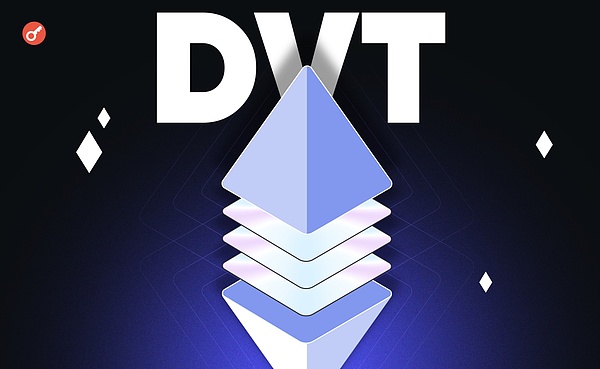
The following is a detailed introduction to DVT in Etherfi:
3.3.1The core concept of DVT
In the traditional Ethereum pledge mode, a verification device is usually managed by a single node operator.This model may introduce centralized risks in some cases. For example, if node operators are unreliable or attacked, they may affect the performance and safety of the verification device.
DVT has allowed multiple independent entities to jointly manage a single authentication, which disperse the risk of a single point.There are several key advantages in this way:
-
Enhanced security: Since the authentication is no longer relying on a single entity, the risk of being attacked or abused has been reduced.
-
Improved decentralization: The participation of multiple managers further decentralized the network, which is in line with the core principles of Ethereum ecosystem.
3.3.2The working principle of DVT
-
Key segmentation: In DVT, the key to control the verification device is divided into multiple fragments, and each entity holding the management of each participation is part of it.Only when most or all fragments are combined can the verification device operate.
-
Consensus mechanism: Managers need to reach a consensus to perform key operations, such as update, withdrawal, or other key configuration changes of the verification device.
-
Contracts and agreements: DVT participants usually have clear contracts and agreements to regulate everyone’s responsibilities and rights to ensure the fairness and transparency of the entire system.
3.3.3The implementation and challenge of DVT
The implementation of DVT faces some technical and operating challenges, mainly including:
-
Technical complexity: The implementation of key division and consensus mechanism requires high technical capabilities and accurate implementation.
-
Coordination and cooperation: The coordination and cooperation of multiple independent entities may have difficulty, especially when facing the network consensus or emergency situation.
-
Laws and compliance: The laws and regulatory requirements of different regions may affect the implementation of DVT, especially on the protection of funds and data protection.
4. ETHFI tokens
Etherfi tokens (ETHFI) is the native currency of the Etherfi platform and has a variety of uses to support decentralized pledge and node operation activities of the platform.

The following is a detailed introduction about ETHFI tokens:
4.1Token function and use
-
Payment agreement fee: ETHFI tokens are used to pay various protocol fees generated during transactions and operations on the Etherfi platform.
-
Stimulate pledges and node operators: Through ETHFI tokens, the platform reward users who participate in pledge and running nodes, and encourage them to contribute to the security and stability of the network.
-
Governance voting: Users holding ETHFI albums can participate in the platform’s governance decisions, and vote to decide key protocol updates and changes.
4.2Token distribution and release
-
Total supply: ETHFI’s total supply is 1 billion.The current circulation is 115,200,000 ETHFI, accounting for 11.52%of the total.
-
Public sales and private equity: Etherfi has conducted several rounds of private equity and public sales, attracting the participation of top funds such as Arrington XRP Capital and Consensys.
-
The first exchange issuance (IEO): Etehfi tokens made IEO on Binance Launchpool, of which 2%of which were assigned to this event.

-
The distribution of tokens is: investors and consultants: 32.5%, DAO vault: 27.2%, team: 23.3%, funds: 11%, liquidity: 3%, Binance launched pool: 2%, Agreement Association: 1%
-
Token release

4.3Security and stability
-
Security Audit: Etherfi Agreement and their smart contracts have passed the audit of a number of top security companies including Certik and Zellic, ensuring the security and reliability of the platform.
4.4Governance and future planning
-
DAO governance: ETHFI token holders can participate in the decentralized autonomous organization (DAO) to affect the development direction of the platform through voting.
-
Technology development: Etherfi plans to continue to promote technological innovation, including expanding its decentralized verification device technology (DVT) and improving the openness and authority model of smart contracts.
4.5Ethfi airdrop

-
Overview of airdrops: In the first season, those users who cast Etherfan NFT (the price 0.01 ETH) received 430 ETHFI token airdrops, and these tokens were worth about $ 36,000 at that time.In addition, those users who pursed EETH on Etherfi have also received additional tokens.The second season has begun and once again announced the airdrop with community members participating in Liquid.
-
Liquid platform: LIQUID is an automated Defi strategy vault that allows users to use their EETH to easily participate in the DEFI ecosystem.Users only need to deposit EETH, WEETH or WETH, and the vault will allocate these assets in multiple DEFI positions.
-
Ranking and loyal point: StakeRank is a system with 8 levels. The user can increase a level 100 hours of ETH every 100 hours of pledged. Each level has a gradual increase in the number of loyal points.The pledge balance requires more than 0.1 EETH to continue to upgrade.
-
Other incentives: The users who participated in the first quarter event will start in the second quarter.Etherfan NFT holders will automatically upgrade to the third level.
-
Quarterly conversion: In order to fairly handle the participants in the first and second quarters, the accumulation rate of each person’s loyal point will increase by 10 times.Although they dilute the old points, they are still calculated based on the following conditions.
4.6ETHFI token performance analysis

-
As of now, the price of ETHFI tokens is 3.68 US dollars, down 6.20%in a day.
-
Market capital: The market value is US $ 424 million, ranking 160th in all cryptocurrencies.This shows that it has a relatively small but considerable share in the encryption market.
-
24 -hour transaction volume: The transaction volume increased by 15.78%, reaching about 157 million US dollars.This may indicate that the market activity is increased, the transaction interest rises or the price fluctuations increase.
-
24 -hour transaction volume/market value ratio: This ratio is 37.05%, which is relatively high, indicating that the tokens’ trading activities in the past 24 hours are quite active.
5. Team/partner/financing situation
5.1team
Etherfi team consists of a number of professionals in the field of blockchain and decentralized finance
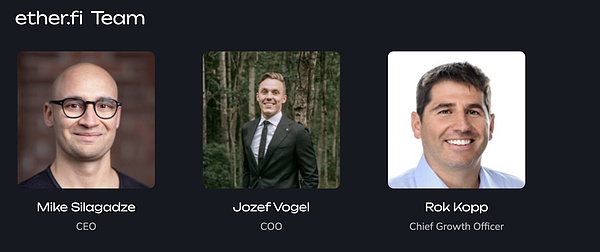
-
Mike SiLagadze (founder and CEO):Mike has been investing in cryptocurrencies since 2010, and has previously founded Top Hat.He has a bachelor’s degree from the University of Waterloo.
-
Chuck Morris (Deputy President, Chief Engineer):Chuck has established and led the engineering team for more than ten years.He has a master’s degree in computer science at the University of Chicago.
-
Rok KOPP (Customer Successful Director):Rok has a bachelor’s degree in the Virgin University and has more than ten years of startup sales and marketing experience.
5.2Partner
Etherfi has now established a partnership with many parties, such as:
-
Kiln: Provide infrastructure services for Ethereum, such as node operation or pledge solution
-
DSRV: A company that provides blockchain infrastructure, including node services and other technical support.
-
ChainNodes: A blockchain service provider focuses on node transportation peace management.
-
Obol: Companies focusing on distributed trust agreements or decentralized technologies related to blockchain.
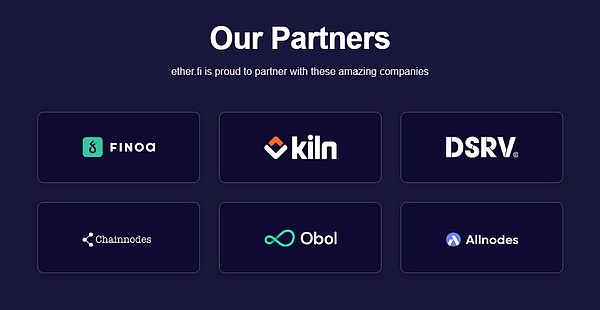
5.3Financing situation
Etherfi has increased significantly through multiple rounds of financing.
Initially, the company completed a round of $ 5.3 million in financing, led by North Island Ventures, Chapter One and Node Capital, including the participation of BitMex founders Arthur Hayes (Coindesk).
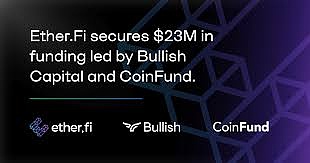
Since then, Etherfi has successfully raised $ 23 million in Series A financing led by Bullish Capital and Coinfund, and other investors such as OKX (Coindesk) have also participated in investment.The capital injection has greatly promoted Etherfi’s operations, enabling it to expand its services and enhance its platform.The A round of financing has increased the company’s capital basis from US $ 103 million to $ 1.66 billion, marking its great growth of its financial and operating scale.These development highlights the steady status of Etherfi in the field of decentralized finance (DEFI), and its continuous attraction for investors who are looking for opportunities in the blockchain and cryptocurrency fields.
6. Project evaluation analysis
6.1Track analysis
Etherfi projects are pledge and liquidity pledge in the field of decentralized finance (DEFI) track.This track focuses on providing decentralized pledge services, especially allowing Ethereum holders to obtain benefits by pledged ETH without liquidity.It is characterized by allowing users to pledge their ETH to the Ethereum network to support network operations and get pledge rewards. At the same time, the corresponding tokens are issued to maintain the liquidity of pledged assets.
Etherfi is mainly for cryptocurrency holders who want to earn income from their assets that they want to earn through their own assets through the pledge mechanism.By providing non -hosting mobile pledge solutions, Etherfi attracted individuals and institutional investors interested in decentralized and scalable financial solutions.
Acts similar to Etherfi include:
-
Lido Finance provides liquidity solutions for ETH2.0 pledge.
-
Another decentralized Ethereum pledged network of Rocket Pool allows users to pledge with a small number of ETH.
-
StakeWise provides decentralized Ethereum pledge services, and users can obtain pledge income through it.
-
Ankr Staking provides a liquidity pledged service that users can pledge their encrypted assets and obtain benefits.
-
MarinaDe Finance provides a platform for similar services for Sorana blockchain.
6.2Project advantage
-
High -total lock value (tvl): TVL, which has a $ 300 million, means that Etherfi has been strongly recognized by the market and has a large amount of funds on the platform.High TVL usually shows that a project has an active user base, strong capital attraction and stable liquidity.
-
Low token inflation rate: Maintaining a low inflation rate (0.46%) in the first year after TGE (tokens) help maintain the stability of tokens, which is attracted to early investors and tokens holdersHuman factors, because it reduces dilution risk.
-
Low FDV/initial market value ratio: The ratio of the market value (FDV) to the initial market value of 11.52%after completely diluted, which indicates that even if all tokens enter the market, the increase in market value is also controllable.The lower FDV/market value ratio may make new investors feel at ease, because it implies that the upper limit of the future token price fluctuations is reasonable.
-
Growth marketing and public relations performance: Strong market growth strategies and public relations activities have shown that Etherfi has performed well in expanding market influence and increasing brand awareness.
-
Experienced team: An experienced team usually means that the project has better execution and higher success probability, because team members may have accumulated valuable experience and resources in related fields.
-
Security audit: The security audit performed by top companies has increased the reputation of the project and provided users with a safe pledge and trading environment, which is particularly important in the field of DEFI.
-
Top fund support: The support of top funds not only provides the necessary funding resources, but also brings the Internet and professional knowledge, which is especially important for startup companies.
6.3Project disadvantage
1. Performance of marketing infrastructure and SEO:
The lack of marketing infrastructure and search engine optimization (SEO) may lead to low visibility on the Internet, and it is difficult to attract new users or maintain the activity of existing users.This may affect the overall growth of the project and brand building.To improve this, Etherfi may need to invest in marketing teams and technology, carry out targeted marketing activities, and optimize its online content to improve search engine rankings.
2. In the second year after TGE, the currency inflation rate is quite high:
The high inflation rate may lead to the dilution of the tokens, which will adversely affect the long -term holders.High inflation may also weaken investors’ confidence in the project, especially if inflation fails to be rationalized through substantive project progress or income growth.Etherfi needs to clearly communicate the causes and management strategies of inflation to ensure the understanding of the community and support its tokens.
3. Lack of transparency of tokens:
If investors and users cannot easily obtain information about tokens pricing, allocation, and belonging conditions, they may have a negative impact on the trust and attractiveness of the project.Transparency is a key factor for establishing investors and community trust.Lack of transparency may lead to insufficient investment decisions and decline in market participation.Etherfi can enhance transparency and credibility by providing detailed token economy white paper, regular updates and public Q & A.
In response to these shortcomings, the Etherfi team may need to make some strategic adjustments, including strengthening its marketing and public relations activities, re -evaluating its token economy model to better manage inflation and improving the overall transparency of the project to ensure long -term sustainable development andCommunity support.
7. Conclusion
Looking forward to the future, Etherfi has several potential development directions:
-
Technology and product iteration: With the development of blockchain and DEFI technology, Etherfi needs to continuously update and optimize its products to maintain competitiveness.Including improving its liquidity re -pledge protocol, adding more integration with other DEFI projects and protocols.
-
Strengthen marketing and user education: In order to expand its user base and market share, Etherfi needs to strengthen its marketing strategy and increase brand awareness and project visibility.At the same time, the project should increase the education of users to help them understand the advantages and operation methods of the project.
-
Response supervision challenges: With the increase in Defi supervision globally, Etherfi may need to adapt to changes in relevant regulations to ensure the compliance of its operation.
-
Cooperation and ecosystem expansion: By cooperation with other DEFI projects and traditional financial institutions, Etherfi can further expand its ecosystem, increase the inflow of users and funds, and increase the market adaptability and attractiveness of their products.
In short, despite the challenge, Etherfi has the potential to achieve long -term success and become pledged service leaders in the field of DEFI with its innovative solution and strong team background.Through continuous technological innovation and market strategy adjustment, Etherfi is expected to occupy an important position in the future blockchain pledge market.

